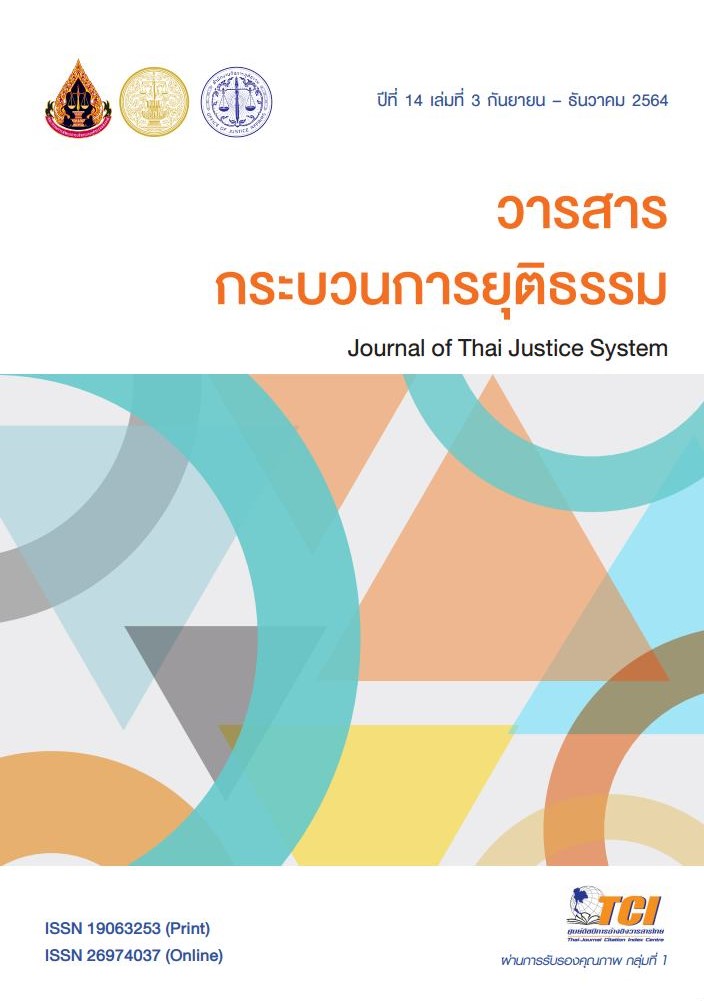การจำแนกลักษณะของละอองเรณูในทางนิติวิทยาศาสตร์โดยใช้ กล้องจุลทรรศน์อิเล็กตรอนแบบส่องกราด
Main Article Content
บทคัดย่อ
คดีสำคัญหลาย ๆ คดี ไม่ว่าจะเป็นคดีที่เกิดขึ้นทั้งในประเทศหรือต่างประเทศ นอกจากวัตถุพยาน เช่น มีด ปืน ค้อน และอุปกรณ์อื่นที่พบได้ในสถานที่เกิดเหตุ หรือวัตถุพยานทางชีวภาพ ยกตัวอย่าง เช่น เลือด เส้นผม เส้นขน น้ำอสุจิ หรือน้ำลายที่สามารถนำไปตรวจ DNA ได้แล้วนั้น ปัจจุบันได้มีการนำความรู้ทางด้านพฤกษศาสตร์มาประยุกต์ใช้กับทางนิติวิทยาศาสตร์เพื่อการติดตามและคลี่คลายคดีที่เกิดขึ้น รวมทั้งสามารถใช้ในการติดตามผู้ที่กระทำความผิดมาลงโทษได้ ไม่ว่าจะเป็นคดีฆาตกรรมที่สามารถตรวจสอบวัตถุพยานได้จากละอองเรณูหรือเศษพืชที่ติดมากับตัวของผู้เสียหายหรือจากศพที่เป็นเหยื่อจากเหตุการณ์ดังกล่าว ดังนั้น ความรู้ทางด้านพฤกษศาสตร์จึงสามารถนำมาประยุกต์ใช้ร่วมกันกับการตรวจหลักฐานทางนิติวิทยาศาสตร์และเป็นอีกวิธีที่มีความน่าเชื่อถือในทางคดี โดยการศึกษาครั้งนี้ มีวัตถุประสงค์เพื่อศึกษาลักษณะสัณฐานวิทยาละอองเรณูของพืชโดยใช้กล้องจุลทรรศน์อิเล็กตรอนแบบส่องกราดและใช้ข้อมูลจากการศึกษามาอธิบายตำแหน่งของสถานที่เกิดเหตุและการติดตามคดี รวมทั้งศึกษาการวิเคราะห์ลักษณะสัณฐานวิทยาละอองเรณูของพืชด้วยเทคนิคการใช้กล้องจุลทรรศน์อิเล็กตรอนแบบส่องกราด โดยการทดลองได้ทำการศึกษาในพื้นที่อำเภอบางละมุง จังหวัดชลบุรี โดยการเก็บตัวอย่างพืชดอกจำนวน 30 ชนิด อัดในแผงไม้อัดแห้ง เตรียมตัวอย่างสำหรับวิเคราะห์ และนำไปวิเคราะห์ผ่านกล้องจุลทรรศน์อิเล็กตรอนแบบส่องกราด โดยศึกษาลักษณะสัณฐานวิทยาของละอองเรณูของพืชชนิดต่าง ๆ ประกอบไปด้วย ขนาด รูปร่าง และลวดลายของผนังชั้นเอกซีน ซึ่งจากการทดลองพืชแต่ละชนิดมีขนาดตั้งแต่ขนาดเล็กมาก (<10µm), ขนาดเล็ก (10 – 25 µm), ขนาดกลาง (25 – 50 µm) และขนาดใหญ่ (25 – 50 µm) รูปร่างมีทั้งหมด 4 แบบ คือแบบ Sub-Elliptic, Elliptic, Elliptic-circular และ Circular และลวดลายของผนังชั้นเอกซีน ซึ่งมีลักษณะที่สังเกตได้ทั้งหมด 8 แบบ
โดยพืชสายพันธุ์เดียวกันแต่ต่าง Species กัน ก็จะมีลักษณะทางสัญฐานวิทยาของละอองเรณูที่ต่างกัน ยกตัวอย่างพืชที่ทำการศึกษาครั้งนี้คือ ต้นหางนกยูงไทย และต้นหางนกยูงฝรั่ง ซึ่งทั้งสองชนิดมีขนาด รูปร่าง และลวดลายบนผิวของเรณูที่แตกต่างกันอย่างสิ้นเชิง
Article Details
ต้นฉบับที่ได้รับการตีพิมพ์ในวารสาร เป็นลิขสิทธิ์ของวารสารกระบวนการยุติธรรม แต่ความคิดเห็นที่ปรากฏในเนื้อหาของบทความในวารสารกระบวนการยุติธรรม ถือเป็นความรับผิดชอบของผู้เขียนแต่เพียงผู้เดียว
เอกสารอ้างอิง
กรณ์ กรภัทรชัยกุล, ไซหนับ ยู่โซะ, ทิพวรรณ คงอินทร์ และรูซีลา สะลูโว๊ะ. (2558). สัณฐานวิทยาความมีชีวิตและการงอกของเรณูพืชดอก 15 ชนิด. วารสารวิทยาศาสตร์และเทคโนโลยี, 23(4). 622-632.
ณัฐนรี เอียดประพาล. (2561). การแพร่กระจายและศักยภาพของพยานหลักฐานทางนิติเรณูวิทยาในชุมชนเมืองและการสอบเทียบวิธีการเก็บตัวอย่างเปรียบเทียบจากสถานที่เกิดเหตุ. วิทยานิพนธ์วิทยาศาสตรมหาบัณฑิต. มหาวิทยาลัยสงขลานครินทร์.
ทิพย์สุดา ตั้งตระกูล. (2554). รายงานผลการวิจัย เรื่อง การศึกษาความหลากหลายของละอองเรณูพืชในพื้นที่โครงการอนุรักษ์พันธุกรรมพืชอันเนื่องมาจากพระราชดำริ สมเด็จพระเทพรัตนราชสุดาฯ สยามบรมราชกุมารีมหาวิทยาลัยแม่โจ้. เชียงใหม่: มหาวิทยาลัยแม่โจ้.
นิติญา แจ้งกระจ่าง, เสาวณี สาธรวิริยะพงศ์ และวิทยา สาธรวิริยะพงศ์. (2549). สัณฐานวิทยาและการงอก ละอองเรณูของส้มเปลือกล่อนในสภาพทดลองและสภาพธรรมชาติ, กรุงเทพฯ: สำนักงานกองทุนสนับสนุนการวิจัย.
ปราณี อินสุทน และเบญจวรรณ ชิวปรีชา. (2561). เรณูวิทยาของพืชวงศ์ถั่วบางชนิดในจังหวัดภูเก็ต. วารสารวนศาสตร์, 37(1), 16-30.
พัทธมน กัณชัย. (2551). การแสวงหาพยานหลักฐานคดีเกี่ยวกับคอมพิวเตอร์กับการเปลี่ยนแปลงเป็นสังคมที่พึ่งพาเทคโนโลยี เชียงใหม่: มหาวิทยาลัยเชียงใหม่.
ฟิสิกส์ราชมงคล. (2555). อ่านอดีตด้วยละอองเรณู. ค้นเมื่อ 27 สิงหาคม 2562, จาก http://www.rmutphysics.com/charud/naturemystery/sci1/flower/flower.htm
ลาวัลย์ รักสัตย์. (2534). เอกสารประกอบการเรียนการสอนเรื่องละอองเรณู. กรุงเทพฯ: มหาวิทยาลัยเกษตรศาสตร์.
วงศ์กฏ ภู่ภูมิรัตน์, (2551). การเสื่อมสภาพของเรณูในผิวหน้าดินและผลของการเสื่อมสภาพต่อความเป็นไปได้ในการเป็นหลักฐานทางนิติวิทยาศาสตร์. วิทยานิพนธ์ปริญญานิติวิทยาศาสตร์มหาบัณฑิตมหาวิทยาลัยสงขลานครินทร์.
สฤษดิ์ สืบพงษ์ศิริ. (2558). บทบาทของงานนิติโบราณคดีและนิติมานุษยวิทยาในการสืบสวนอาชญากรรม. วารสารวิชาการอาชญาวิทยาและนิติวิทยาศาสตร์, 3(1), 20-36.
หนังสือต่างประเทศ
Bryant, J. R., Jones, J. G., & Mildenhall, D. C. (1990). Palynology. Jounal of Forensic palynology in the United States of America, 14(1), 193–208.
Brewbaker, J.L. & Kwack, B.H. (1963.) The essential role of calcium ion in pollen germination and pollen tube growth. American Journal of Botany, 50(9), 859-865.
Cochran, W. G. (1953). Sampling techiques. New York: John Wiley & Sons.
Erdtman, G. (1952). Pollen morphology and plant taxonomy : Angiosperms. An Introduction to Palynology. Science, 117(3030), 86-87.
Erdtman, G. (1969). An introduction to the study of pollen grains and spores. Journal of Botanical Taxonamy and Geobotany, 1971(81), 656-657.
Forensic Palynology. (2010). Forensic palynology. Retrieved August 1, 2017, from https://www.slideshare.net/vlee86/forensic-palynology
Horrocks, M., & Walsh, A. J. K. (1998). Forensic palynology : Assessing the value of the evidence. Review of Palaeobotany and Palynology, 103(1-2), 69-74.
Mildenhall, D. C. (2006a). An unusual appearance of a common pollen type indicates the crime. Journal of Forensic Science International, 163(3), 236-240.
Mildenhall, D. C. (2006b). Hypericum pollen determines the presence of burglars at the scene of a crime: An example of forensic palynology. Journal of Forensic Science International, 163(3), 231-235.
Midenhall, D. C. (2008). Civil and criminal investigations. The use of spores and pollen. SIAK-Journal, 4, 35-52.
Vaughn M. B., John G. J., & Dallas C. M. (1990). Forensic palynology in the United States of America, Palynology, 14(1), 193-208.


